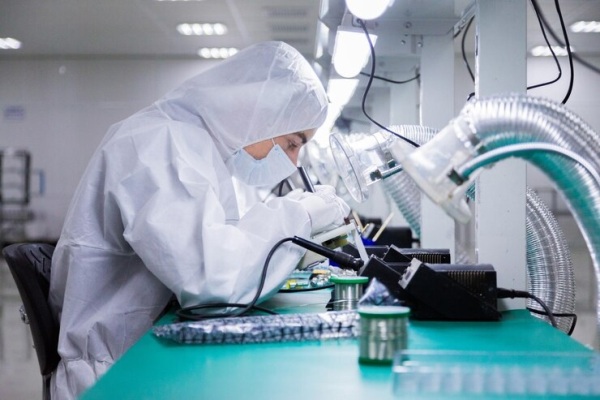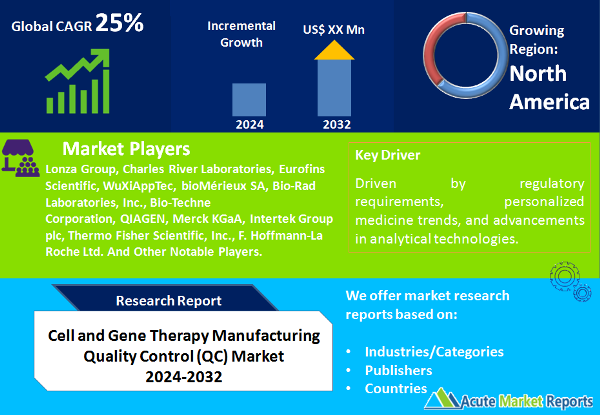
The cell and gene therapy manufacturing quality control (QC) market is expected to grow at a CAGR of 25% during the forecast period of 2025 to 2033. Cell and gene therapy manufacturing quality control (QC)plays a pivotal role in ensuring the safety, efficacy, and consistency of cell and gene therapies. The cell and gene therapy manufacturing QC market is driven by regulatory requirements, personalized medicine trends, and advancements in analytical technologies. Despite the complexity of product characterization, the market is poised for growth due to the increasing adoption of cell and gene therapies. Equipment and accessories and Process Development segments are expected to exhibit significant growth during the forecast period. Geographically, Asia-Pacific presents opportunities for expansion. Industry leaders' strategies focus on technology integration, capacity expansion, and comprehensive QC solutions to address the evolving demands of cell and gene therapy manufacturing quality control.
Stringent Regulatory Requirements
The QC market for cell and gene therapy manufacturing is driven by stringent regulatory requirements imposed by health authorities such as the FDA and EMA. Regulatory agencies demand rigorous quality control measures to ensure that cell and gene therapies meet safety and efficacy standards. For example, the FDA's guidelines for chemistry, manufacturing, and controls (CMC) emphasize thorough testing, characterization, and validation to ensure the quality and consistency of therapies. The regulatory landscape serves as a significant driver for investments in QC infrastructure and technologies.
Growing Adoption of Personalized Medicine
The rise of personalized medicine, wherein therapies are tailored to individual patients, has amplified the demand for robust QC procedures. Cell and gene therapies are often customized for each patient, requiring precise characterization, identity confirmation, and potency testing. As cell and gene therapies become more mainstream, the QC market experiences a surge in demand for advanced analytical methods and technologies to ensure therapy-specific quality and patient safety.

Advancements in Analytical Technologies
Rapid advancements in analytical technologies, such as high-throughput sequencing, mass spectrometry, and flow cytometry, have revolutionized the QC landscape. These technologies enable comprehensive characterization and analysis of cell and gene therapies, including their genetic makeup, purity, and potency. The integration of cutting-edge analytics into QC processes not only enhances the quality and reliability of therapies but also expedites development and manufacturing timelines.
Complexity of Product Characterization
A key restraint in the cell and gene therapy manufacturing QC market is the complexity of product characterization. Cell and gene therapies are often multifaceted and involve various components, making their comprehensive characterization challenging. The heterogeneity of cell populations, genetic modifications, and therapeutic mechanisms necessitates advanced analytical techniques that can accurately assess product quality. This complexity can lead to prolonged QC timelines and increased costs.
Consumables Dominate the Market by Component
The market is segmented by component into Equipment and accessories, Consumables, and Others. In 2024, Consumables accounted for the highest revenue share, primarily due to their continuous usage in cell and gene therapy QC processes. During the forecast period from 2025 to 2033, Equipment and accessories are projected to exhibit the highest CAGR. The adoption of advanced equipment and technologies, such as next-generation sequencers and high-performance liquid chromatography systems, is expected to drive this growth.
Downstream Processes Dominate the Market by Process
The market is further segmented by process into Upstream Processes, Downstream Processes, and Process Development. In 2024, Downstream Processes generated the highest revenue, attributed to the need for purification and isolation of therapeutic cells and genetic material. However, during the forecast period, Process Development is anticipated to achieve the highest CAGR. The focus on optimizing and scaling up manufacturing processes to ensure consistent product quality is driving investments in process development and associated QC strategies.
North America Remains as the Global Leader
North America held the highest revenue share in 2024, driven by its established cell and gene therapy ecosystem, supportive regulatory environment, and significant research and development activities. However, the Asia-Pacific region is projected to witness the highest CAGR from 2025 to 2033. Increasing investments in healthcare infrastructure, rising research collaborations, and the emergence of contract manufacturing organizations (CMOs) are driving the growth of the QC market in this region.
Market Competition to Intensify during the Forecast Period
Prominent players in the cell and gene therapy manufacturing QC market include Lonza Group, Charles River Laboratories, Eurofins Scientific, WuXiAppTec, bioMérieux SA, Bio-Rad Laboratories, Inc., Bio-Techne Corporation, QIAGEN, Merck KGaA, Intertek Group plc, Thermo Fisher Scientific, Inc., and F. Hoffmann-La Roche Ltd. These companies provide a wide array of QC services, analytical tools, and expertise tailored to the unique challenges of cell and gene therapies. Key strategies involve investing in advanced analytical technologies, expanding testing capabilities, and offering comprehensive QC solutions that support product development, manufacturing, and regulatory compliance. The market is characterized by strategic collaborations and partnerships to address evolving QC needs.
Historical & Forecast Period
This study report represents analysis of each segment from 2023 to 2033 considering 2024 as the base year. Compounded Annual Growth Rate (CAGR) for each of the respective segments estimated for the forecast period of 2025 to 2033.
The current report comprises of quantitative market estimations for each micro market for every geographical region and qualitative market analysis such as micro and macro environment analysis, market trends, competitive intelligence, segment analysis, porters five force model, top winning strategies, top investment markets, emerging trends and technological analysis, case studies, strategic conclusions and recommendations and other key market insights.
Research Methodology
The complete research study was conducted in three phases, namely: secondary research, primary research, and expert panel review. key data point that enables the estimation of Cell And Gene Therapy Manufacturing Quality Control (QC) market are as follows:
Market forecast was performed through proprietary software that analyzes various qualitative and quantitative factors. Growth rate and CAGR were estimated through intensive secondary and primary research. Data triangulation across various data points provides accuracy across various analyzed market segments in the report. Application of both top down and bottom-up approach for validation of market estimation assures logical, methodical and mathematical consistency of the quantitative data.
| ATTRIBUTE | DETAILS |
|---|---|
| Research Period | 2023-2033 |
| Base Year | 2024 |
| Forecast Period | 2025-2033 |
| Historical Year | 2023 |
| Unit | USD Million |
| Segmentation | |
Component
| |
Analytical Method
| |
Process
| |
End-User
| |
|
Region Segment (2023-2033; US$ Million)
|
Key questions answered in this report